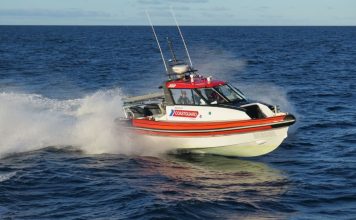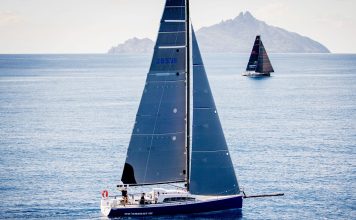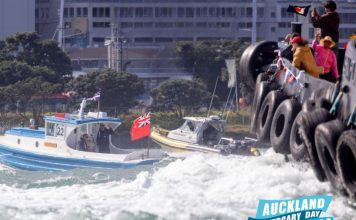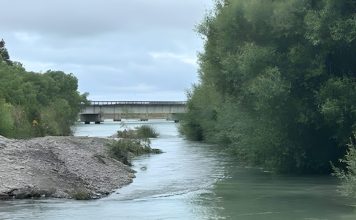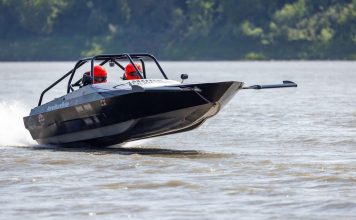Coastguard Mana’s new 12.5m Protector rescue vessel Te Awarua might look much the same as 21 other Protectors that make up Coastguard’s new fleet of ex-America’s Cup vessels, but there’s a clear difference – it’s powered by a pair of OXE300 three-litre, straight-six, twin-turbo diesel 300hp outboards.
Boating NZ went aboard this vessel in Auckland just prior to its delivery down-country to Coastguard Mana near Wellington, getting an opportunity to drive the boat and experience OXE Diesel outboards first-hand – see panel.
Te Awarua is the first twin OXE 300hp diesel outboard commercial fitout in New Zealand. It represents a new generation of vessels for Coastguard, taking advantage of new technology and enabling Coastguard units to be better care for the environment.

“As one of the first Coastguard units to explore the diesel option – as well as for making a significant financial commitment to spearhead this project – Mana should be very proud to fly this flag for Coastguard,” said Coastguard Head of Operations Rob McCaw.
“Coastguard had outstanding support on this ground-breaking project, especially from Rayglass, OXE Marine and Power Equipment, all of which provided industry-leading experience, technology and skills.”


Why diesel?
Coastguard Mana has long been due a new vessel – the vessel Te Awarua replaces originally came from Coastguard Howick. An older vessel, it was showing signs of wear and tear and suffered frequent maintenance issues, which impacted the unit’s operational readiness.
So Mana was high on the list to receive a new vessel as part of the unique partnership between Coastguard, Lotto and ETNZ, which saw the support boats from the America’s Cup, refitted and rebranded as Coastguard rescue vessels.
Most of the ex-ETNZ support vessels have conventional petrol outboard power. However, environmental protection measures in place at Mana Marina don’t allow petrol refilling – so for Coastguard, diesel outboards make perfect sense.
“The move to diesel outboards is something that Coastguard, which has the largest commercial fleet in New Zealand, has been considering for several years. Environmental protection and cost efficiencies are just two of the key factors,” says Rob.

Coastguard Mana operates on an expansive stretch of coastline, with often rough sea conditions posing a number of challenges when responding to an incident. The move from their current 9.5m Protector to the diesel-powered 12.5m Protector is a gamechanger for this hard-working group of volunteers.
Coastguard Mana President Tara Doak says the whole unit is grateful to be receiving the new boat, which will improve the safety of the unit when dealing with call-outs in what can be a very rough body of water.
“We service the northern entrance of the Cook Strait, which provides constant challenges – not only dealing with the lee shore, but once you’re out there, there are no harbours or places of refuge, so if you get into trouble it’s often big trouble.
“This new vessel is really going to be a gamechanger for us. The outboards have been set up to provide pulling power and a useful cruising speed, giving us that extra advantage in the water when it’s crucial.”
The vessel is also equipped with all the latest technology to help Mana Coastguard do its job and maintain stable communication between its people.”

Benefits stack up
One of the biggest questions for Coastguard, and indeed the wider boating industry, is the argument around whether diesel is better than petrol for the environment. The key factors being reduced CO2 emissions and reduced fuel consumption.
The OXE Diesel engine emits significantly lower CO2 than a petrol outboard engine. Burning one litre of diesel produces approximately 2.69kg CO2 while one litre of petrol produces 2.36kg CO2 , but since the OXE Diesel consumes up to 46% less fuel than comparable petrol alternatives, it reduces CO2 emissions by over 35.5%. During Coastguard’s sea trials, Te Awarua was consuming 33% less fuel compared to similar petrol outboards.
With significantly lower fuel consumption, OXE Diesel power also provides Coastguard Mana unprecedented range and volunteers have the ability to refuel from larger diesel-fuelled vessels or marine-based platforms, adding to the vessel’s versatility.

The powerhead of the OXE300 is a marinised bi-turbo automotive configuration from BMW that provides 680Nm (502ft-lb) of torque at the crankshaft at 1750rpm; at 1000rpm the engine provides over 500Nm (369ft-lb).
At the propeller shaft, the torque numbers translate to 945Nm (696ft-lb) of turning force – figures previously unheard of in the outboard industry. This torque provides Te Awarua with massive bollard pulling power, as well as impressive hole-shot acceleration.
“OXE Marine’s OXE Diesel was developed for arduous situations just like those Coastguard needs to be prepared for. Reliability is key when it comes to these often-critical situations, and combining the high torque of the OXE300 with safety functions like crash-stop capability and low-speed control, our demanding users can rely on their OXE to get them out there and back, safe and sound,” says Douglas Natoce, President of OXE Marine.
“The incredible fuel efficiency of the OXE300 means more ocean covered and more time saving lives. And if run on biofuel, total net CO2 emissions are reduced by up to 94.2%.”
Evolution for the Coastguard fleet
Coastguard’s decision to opt for diesel outboards highlights the strength of the organisation and offers an opportunity to streamline core functions such as servicing.
While the price point of diesel engines is more than double that of equivalent petrol alternatives, their service life is over five times longer. That means the same engines can be used for longer, slashing Coastguard’s overall carbon footprint. Whereas a petrol engine may have to be replaced up to four times during the lifetime of a Coastguard rescue vessel, a diesel ouboard might only need replacing once, if at all.

Add in the fact that service intervals for diesel engines are four times longer than petrol engines, and the whole life cost equation begins to stack up very favourably for diesel.
For more isolated Coastguard units, diesel engines also come with another servicing benefit – the local mechanic. As the OXE Diesel outboards are fundamentally the same as a BMW X5, most issues can be fixed by an automotive engineer. Units like Mana can engage with local engineers, diagnose problems and get back out on the water quicker.
“The new Coastguard Mana vessel will be at the cutting-edge of technology and test the viability of rolling diesel outboards out across the rest of the outboard fleet in the future,” explains Rob McCaw.
ON THE WATER
Te Awarua is one of four 12.5m Rayglass Protector vessels ETNZ used as support boats for the last America’s Cup – the smaller 9m Protectors also being rolled out to Coastguard units around NZ were used by the marshals.
The 12.5m Protectors can accommodate up to four outboards but were mostly fitted with twin 350hp petrol V8s. They easily support the OXE Diesels, which each weigh around 95kg more than the petrol outboards they replace.

The OXE Diesels are based around automotive diesel engines from BMW’s 5-Series, which means easy access to service and spare parts, explained John Kotke, Coastguard’s AC36 Project Manager.
“While we typically replace a petrol outboard every 2000 hours or five years, we are expecting a service life of 10,000 hours from the OXE outboards. That offers us huge benefits when it comes to reliability and readiness to respond.”
John reckons the engines will easily pay for themselves long before they will need replacing.
Te Awarua will be housed on a lifting cradle inside Mana Marina. The all black engines with their massive cowlings are imposing looking beasts. Engine power is transferred to the propellers via a belt drive, which contributes to surprisingly quiet operation. Communication between crew members is important during rescue missions, so excessively noisy engines are undesirable.
Performance is strong. An abundance of torque ensures impressive hole-shots and excellent response through the lower and middle parts of the rev range. Coastguard have optimised the rig for pulling power, fitting 15-inch propellers. Nevertheless, top speed is still around 32 knots, only a few knots shy of the same vessel with twin 350hp petrol outboards – not bad considering the diesel rig is heavier and lacks 100hp.
The vessel cruises very comfortably anywhere between 20 and 30 knots, each engine burning around three litres per nautical mile.

For close quarters work, the OXE outboards, set far apart on the transom, afford excellent low speed control both in forwards and reverse, aided by the bow thruster. Engine controls and displays are electronic and the steering is Optimus electric. – John Eichelsheim.
















